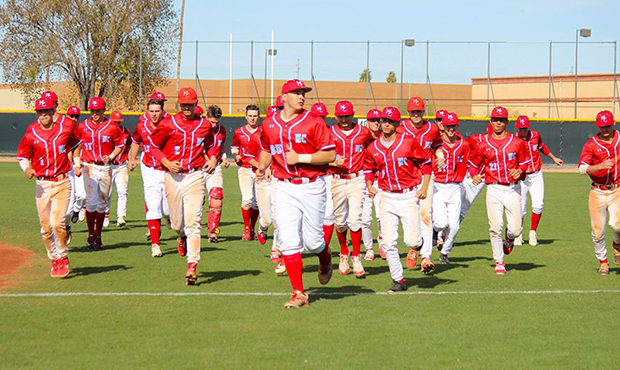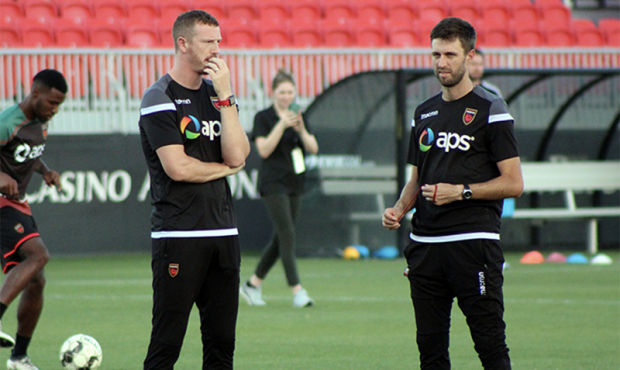Ultra-runner reflects on record-breaking 800-mile Arizona Trail run
Nov 5, 2016, 7:19 AM | Updated: Nov 6, 2016, 7:21 pm

After finishing his 800-mile run of the Arizona Trail, all Michael Versteeg wanted to do was sit at the border and watch the sun rise. (Photo courtesy of Michael Versteeg)
(Photo courtesy of Michael Versteeg)
PHOENIX – “I don’t envy myself for going through that,” ultra-runner Michael Versteeg said with a laugh.
“That” would be his successful attempt at completing the 800-mile Arizona Trail, which stretches from Utah down to Mexico, faster than it has ever been done on foot.
While most in Arizona were fast asleep on the morning of Oct. 19, Versteeg, 31, was shattering a record at the Arizona-Mexico border. At 4:41 a.m. that day, he completed the Arizona Trail after 15 days, 22 hours, 39 minutes, besting the previous fastest known time of 21 days, 14 hours, 16 minutes set by Adam Bradley in 2011.
While Versteeg, who lives in Prescott, has competed in many ultra-running events, he said this was different from anything he has done.
“In some ways I feel like this is the first truly endurance thing I’ve ever done,” Versteeg said.
Paco Cantu, a childhood friend of Versteeg’s who helped as part of his support crew on the last few days of the Arizona Trail, said that their long friendship made seeing Versteeg accomplish his goal even better.
“It was really inspirational for me,” Cantu said. “I’ve known Mike since we were little kids and I’ve been friends with him since he was more interested in playing video games and drinking soda than going on a run. The pride that I felt for him kind of extended much further back.”
Matthew Nelson, executive director of the Arizona Trail Association, was skeptical that Versteeg would be able to complete it and break the record. But after seeing his result, there wasn’t much to say.
“I’m speechless,” Nelson said. “Quite honestly I think he’s single-handedly redefined what we know to be possible both on the Arizona Trail or really on any long distance trail for that matter.”
While Versteeg said he didn’t have too much of an emotional reaction upon completion, simply because of how drained he was from the experience, later on he was able to express how he felt about his accomplishment.
“I actually can say without too much vanity that I am very proud of myself for being able to hit 16 days,” Versteeg said. “I’m pretty proud of myself for being able to hit 50 miles a day through that terrain.”
Keeping pace
Versteeg began his 800-mile odyssey at the Arizona-Utah border on the morning of Oct. 3 and looked to keep up a 50-mile-per-day pace throughout.
“First day, I felt fine and ready to go and I felt like I had done all the preparations I could’ve done up to that point,” Versteeg said. “I was able to do 58 miles the first day, which was right on plan, right what I thought I wanted to do.”
Nelson has seen many people attempt the Arizona Trail over the years, along with some that thought they could top Bradley’s record. While most say they’ll do 50 miles a day, in his experience, it never lasts.
“I thought, like most people, that I would see his mileage go from 50 a day to 40 to 30, which is what most people end up doing,” Nelson said. “But the fact that he kept it up, I just kept thinking he’s going to blow up, he’s going to crack, he’s going to cook. And then every day he just kept doing it.”
“Generally the Arizona Trail has not been thought of as something that could be run,” Versteeg said.
Cantu said that he’s run races with Versteeg and crewed for him in other events, and was surprised at how he held up in an undertaking like this.
“All things considered, he was in such great shape. I was sort of amazed, especially because I’ve seen him in much worse shape on other runs,” Cantu said. “He was always lucid and with it. He always knew what was going on, always thinking ahead to the next leg of the trip and what he needed.”
No matter what happened out on the trail, Versteeg said that all his focus remained on getting that 50 miles a day. Without that, he’s wasn’t sure if he could’ve done it.
“I was just completely obsessed and completely one-track minded on hitting my mileage every day,” Versteeg said. “That’s the only way I did it.”
Troubles on the trail
Versteeg’s decision to go from north to south afforded him what Nelson said is widely considered the easier parts of the trail first. That’s also how he was able to hit more than 50 miles a day for much of that section.
“All of the easy passages are in the north,” Versteeg said. “The northern part of the trail is significantly easier than the southern part of the trail. So I was intentionally going over in my mileage, anticipating that I wouldn’t necessarily be able to hit that every day in the southern section.”
“The northern half of the state is, for all intents and purposes, except for Grand Canyon, a flat section of the trail,” Nelson said. “But once you drop off and you enter the Sky Islands of southern Arizona, it’s just one mountain range after another. The elevation gain and loss in that part of the state is just brutal.”
It was in the Sky Island ranges, which are strung together in southern Arizona, that Nelson believed Versteeg could get tripped up.
“I thought unless he is superhuman, he’s still got the Catalinas and the Rincons and the Santa Ritas and the Canelos and the Huachucas,” Nelson said. “So five mountain ranges to go, and any one of those could completely break him.”
Versteeg noted that the trail also becomes much less structured once you get into the southern part.
“The trails are just basically nonexistent at this point,” Versteeg said. “You’re bushwhacking most of the day. You’re bushwhacking, you’re route-finding. You’re getting torn up by cactus and you’re getting torn up by bushes and that’s in the middle of doing really huge, giant climbs on really, really rough terrain.”
While the mountains may sound tough, and would be for many people, Versteeg said that it was the overgrown grass that had taken hold of the southern leg of the trail that was the worst part of the experience.
“I would run five minutes and my shoes and socks and feet would just get completely full of really, really painful stickers,” Versteeg said. “I was having to, every five minutes, having to stop and spend 20 minutes ripping things out of my feet and out of my shoes. And then also my legs were so torn up from all the Cat’s Claw that was hidden in the grass that my legs were starting to have an allergic reaction to the grass.”
His feet were just as bad, and eventually he turned to an unconventional solution to the problem.
“I was getting so many things in my feet that my feet were beginning to have a crazy allergic reaction of crazy bumps all over them and they would swell,” Versteeg said. “I started to get blisters because my feet weren’t fitting into my shoes anymore because of the allergic reaction to this grass. So the only thing I could do at a certain point was wrap my entire feet and legs in duct tape so I could get through these sections because it literally was impassable.”
Even his solution created new issues and didn’t prevent all of the original problems.
“What that was doing was it wasn’t allowing my feet to breathe,” Versteeg said. “So my feet were getting really wet.”
The result was swelling, blisters and more of the allergic reaction.
“My feet just totally fell apart the last few days,” he said.
Nelson said that the grasses are a natural part of what happens to the trail after the summer rains. However, he said that the rain this year caused the grass to be worse than usual.
“Every time it rains in the monsoon season – July, August, September – we have these massive grass blooms,” Nelson said. “Normally when some of those grasses would be dying back, they got a second round. And so we’re seeing not just grass growing chest high on the side of the trail, but because there was so much water, we’re seeing it grow right up through the middle of the trail.”
Cantu could tell just how badly the grass was affecting Versteeg.
“He was definitely tired as hell and frustrated and uncomfortable and hurting,” Cantu said. “The biggest frustration that I saw him dealing with was grass stickers that would get into the mesh of his shoes and his socks incessantly. I think that part was especially brutal.”
“I can’t overemphasize that enough – how terrible the grass was,” Versteeg said.
Help from the crew
Versteeg was the one who actually ran the whole thing, but he admitted that it would have been much tougher without his crew.
“I obviously could not have done it without them,” Versteeg said. “It was a lot of work on their part.”
Versteeg said that he didn’t have one group of people that were with him the whole time. Instead, there would be different groups that would take over at certain points. Overall he said there were about 12 people who joined him at some point along the way as crew.
Versteeg’s accomplishment will be recognized as the fastest known time for supported passage of the trail.
And while he was making his attempt, Heather Anderson of Edmonds, Washington, also was on the Arizona Trail, breaking Bradley’s self-supported fastest known time by traversing the trail without a crew in 19 days, 17 hours and nine minutes.
Cantu said the main responsibility of a Versteeg’s support crew was to intercept him on the trail and make sure he had what he needed for each leg.
“So that would either be just kind of like power snacks or be like a whole meal,” Cantu said. “And also the responsibility is to stock him up, refill his water bottles, stuff his running vest with a sandwich, Snickers, Twix bars, some power-packed food that he could access.”
Versteeg said the support was invaluable.
“They’re waking up, they’re driving to the next place,” Versteeg said. “They’re making food. They’re setting up my camp, setting up my bed. Doing all of that stuff. Taking care of me, washing my clothes, picking stickers out of my shoes, picking stickers out of my socks.”
Versteeg said that he went through around 30 pairs of socks on the trek. His feet were a major concern for the crew.
“I think taking care of his feet was like a number one priority,” Cantu said. “At pretty much every location, Mike was changing socks and shoes. He was kind of alternating between a couple of pairs of shoes.”
The crew joined Versteeg for the final 1.8 miles of the trail, which extends from the last trailhead to the actual border with Mexico. When they got to the border, he was happy to share the experience with the others.
“We all gave each other hugs and congratulated each other and it was a great moment,” Versteeg said.
He couldn’t overstate what the crew meant to him and how much they helped him out.
“They did an amazing job,” Versteeg said. “I feel really appreciative and totally indebted to all the people who came out and did that.”
Setting the record
While some may have doubted that Versteeg would be able to break the record, he said that he knew early on that the pace he had been doing afforded him ample time to do it.
“Halfway through this thing we had figured out I could’ve run 30 miles a day at the second half of it and still broke the record,” Versteeg said.
Instead, his main focus was on his personal goal of completing the Arizona Trail in around 16 days, meaning maintaining a 50-mile-a-day pace the whole time.
“Mentally, I committed to 16 days. I committed to the 50 miles a day,” Versteeg said. “Mentally, I just embraced it and committed to it. That’s what I was going after. That was my own personal goal. It didn’t have anything to do with the record.”
For anyone who wanted to follow along with Versteeg as he tried to break the record, he wore a SPOT tracker, a GPS device that pinpointed his location every few minutes and sent it to a tracking website.
“Him having a spot tracker was fun,” Nelson said. “It allowed people like me or anybody who was interested to be able to see what kind of pace he was keeping or where he was.”
As for his new record, Nelson, Cantu and Versteeg all think it could be broken – eventually.
“I think it could be broken, and I think that someone can do it,” Cantu said. “I think it will stand for a really long time and I don’t think it’s going to be easily or quickly broken.”
“Is it possible to break it? Sure,” Nelson said. “But, I don’t think we’re going to see that record fall for a really long time.”
“There are better ways of doing it, absolutely,” Versteeg said. “I think that, although the time is good, I do think there’s room there for the time to improve.”
Cantu said he wouldn’t be surprised if it was Versteeg himself that broke his own record.
“I think Mike could break his own record,” Cantu said. “He talked about that, especially with the grass and just having the familiarity that he has now after doing it once. I think that he would be able to do it a little bit faster and more efficiently next time.”
“If everything went perfect, I thought that I could maybe do it faster by a day or two,” Versteeg said. “But everything did not go perfect at all.”
Versteeg said that he is interested to see people come out and attempt to top him.
“I wouldn’t be surprised if next year we saw a handful of attempts on it,” Versteeg said. “I’m excited to watch. I’m excited to see other people go after it.”
Nelson’s only concern is that some people might attempt it without being as prepared as Versteeg was for what the Arizona Trail entails.
“My only fear is that people will think that it’s not as hard as it actually is because he’s redefined what is possible,” Nelson said. “The trail hasn’t gotten any easier just because he did this. It’s just as hard as it was a year ago or 10 years ago. If people undertake even a portion of this thinking that they can do the kind of mileage that he did, they’re in for a search-and-rescue experience – if they’re lucky.”
Wild but wonderful
The Arizona Trail might have been the most difficult thing Versteeg has done, but he wasn’t necessarily clamoring for it to be updated and improved.
“Even with all of those really difficult, crazy, heinous, bushwhacking, getting torn up by cactus and desert plants, getting upset and getting mad and stressed out and overwhelmed and emotional – all of those things – I don’t necessarily want any of those sections to change.” Versteeg said. “I think that’s part of what makes the Arizona Trail the Arizona Trail.”
Nelson said that the Arizona Trail Association is always looking at projects to improve the trail and make it sustainable. However, that doesn’t mean they’re looking to take away the spirit of the trail.
“The beauty of where this trail goes, and what it is, is that it puts you at pretty remote, wild places,” Nelson said. “The more amenities, the more signs, the more reminders of human impact there are, the less I feel like you get a wilderness experience.
“It’ll never be easy. It’ll never be nicely groomed. It’ll never be paved. It’ll always be this wild, back-country experience.”
After his experience, Versteeg said the Arizona Trail is something completely different from some of the other well-known long distance trails in the United States.
“This is not the Pacific Crest Trail. This is not the Appalachian Trail. This is not the same beast,” Versteeg said. “The Arizona Trail is crazy. It throws everything at you.”





